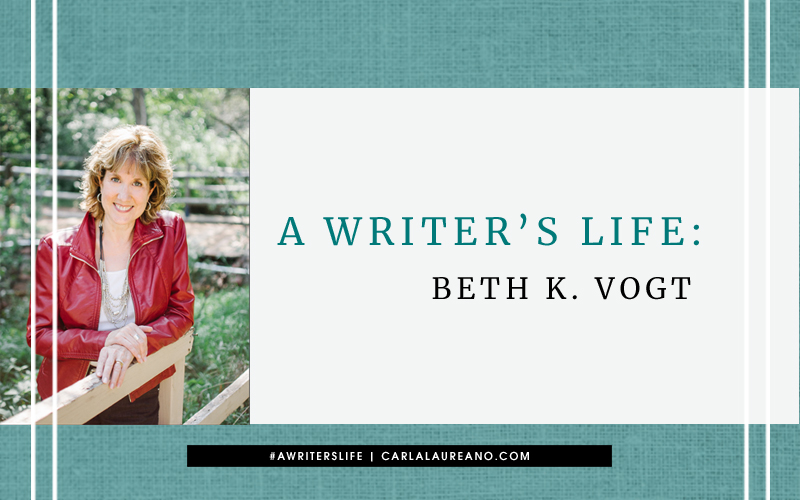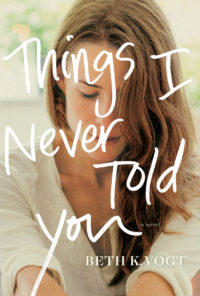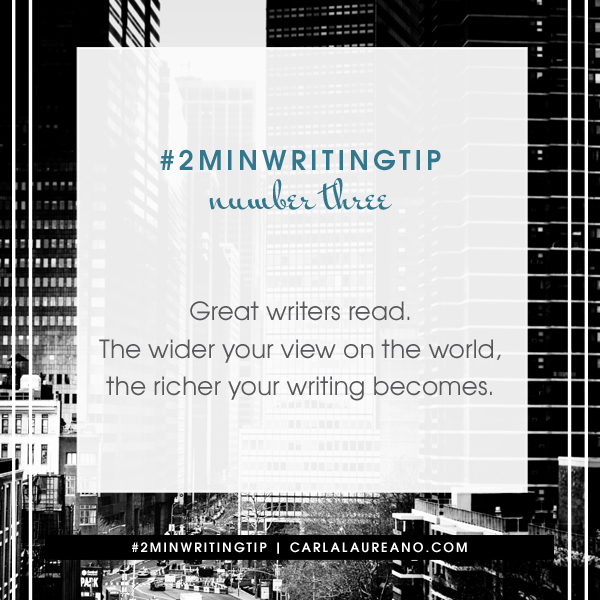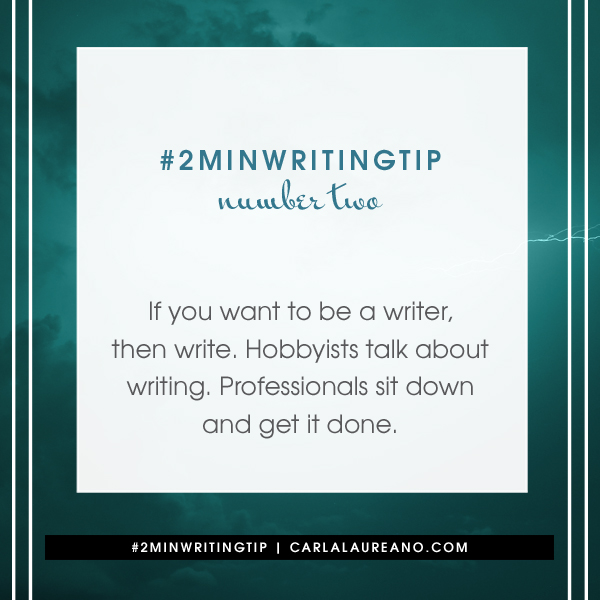Blog
A Writer’s Life: I Can Author Bio with Beth K. Vogt

I’m thrilled to welcome one of my favorite writers and my good friend Beth K. Vogt to the blog today. Her women’s fiction debut, Things I Never Told You, releases tomorrow, and believe me, it’s one you’re not going to want to miss! I had the privilege of endorsing this book, so I’ll let that be my intro:
“Beth K. Vogt has long been a favorite for romance, but she finds her true niche with her first women’s fiction entry, Things I Never Told You. Engaging, sympathetic, and almost painfully honest, this story of buried family secrets and hidden trauma will stay with you long after the last page is turned. I’m impatiently awaiting the other titles in this series. “
Don’t forget to scroll down to the bottom and enter to win a copy of Things I Never Told You!
I Can Author Bio
I have 49 author bios.
That’s right, 4-9. Forty-nine. And no, I do not write under a variety of pen names. I did that once and I have a horror story to go with it.
But that’s another blog post.
Why, you may be wondering, would I have 49 author bios?
That’s what this blog post is about.
The short reason is: I learned ve-ery early on in my writing career to never get rid of an author bio.
The long reason is: I learned that lesson after I had written author bios and gotten rid of them … and I had to recreate my author bio too many times. And every time, I thought, “I’ve already done this! Why am I doing this again?”
Sure, author bios change over time – we write more books, or we final for an award (and win, we hope!)  – or we might change publishers, but we’re still us. I’m decades into this writing gig, and I’m still me: Author Beth. K. Vogt – and the fundamentals of my author bio haven’t changed, especially because I’ve become known for the saying, “God’s best is often found behind the doors marked ‘Never.’” — which often shows up in my author bio now.
– or we might change publishers, but we’re still us. I’m decades into this writing gig, and I’m still me: Author Beth. K. Vogt – and the fundamentals of my author bio haven’t changed, especially because I’ve become known for the saying, “God’s best is often found behind the doors marked ‘Never.’” — which often shows up in my author bio now.
But I’m getting ahead of myself.
Here’s what I’m recommending you do: Start a Word document titled Author Bios, date it 2018, and start keeping a running file of your Author Bios that you store in Dropbox. (You do have Dropbox, right? Or Evernote?) Each year, you’ll change the date of the document in the title.
My first bio in my Word Doc dates back to my nonfiction book, Baby Changes Everything: Embracing and Preparing for Motherhood after 35. That book released in 2007. I have five bios related to this book before I transition to fiction. That makes 44 fiction bios.
Here’s the other thing: there are basically two types of author bios: a long bio and a short bio. Whenever you add a new bio, at the end of it, put the word count in parenthesis, like this: (50). That way, when you do a guest post and the person requests a bio with a specific word length, you can skim your Word doc and find your most recent bio of that length. If you have something close to the length needed, you can tweak it, add or delete words – but then you have a new author bio, right? So update your list – and remember to put the word count at the end.
Also, if you are a regular contributor for a certain blog(s), put that author bio in the Word document, too. That way you always have it in case they (or you) lose it. If you have a media page on your website with a long and short bio – and you should – put those author bios in this Word document, too. Safe, not sorry, right?
I’d love to know how many author bios you compile in your Word document … and remember, you have to start somewhere and sometime, so start today!
Beth K. Vogt believes God’s best often waits behind the doors marked “Never.” Both a Christy Award and an ACFW Carol Award winner, Beth is the author of ten contemporary romance novels and novellas. Her first women’s fiction novel, Things I Never Told You, releases May 2018 from Tyndale House Publishers.
#2MinBookReview: Faithful by Alice Hoffman
This week’s #2MinBookReview turned out to be closer to three minutes… apparently I had a lot to say about this one. And for good reason. I think Hoffman may turn out to be one of my new favorite authors. She’s definitely one of those who makes me feel inadequate about my craft, and that’s a good thing: as a writer, I always want to be learning. She is a master of nuance and writing meaning between the lines. If you enjoy literary fiction, you should check this one out.
Tags: Alice Hoffman, Faithful, literary fiction
#2MinWritingTip – Great Writers Read

The most common advice I see given to writers who want to break into publishing is to read extensively in their genre. And it’s good advice. When you’re starting out, you need to find your place in the industry, know how you fit into what’s already been published and be able to articulate how you’re unique.
The problem begins when you only read in your genre and market segment. Have you noticed that after a while, books begin to sound the same, all using similar plots and devices, even similar language? Part of that is because what you read is integrally related to what you write. If you only put in one type of story, only one type of story will come out. You can become a good writer this way, even a financially successful one, but you’ll never be great.
Great writers fill the well of their inspiration. They’re endlessly curious, and they feed that curiosity by exploring the world through the written word. Literary fiction history, biography, memoir, the newspaper, even blogs on unfamiliar subjects–all widen the writer’s field of vision. The better a writer understands her world, the more empathy she develops by “walking” in another’s shoes, the richer her writing becomes.
[bctt tweet=”Great writers read. The wider your view on the world, the richer your writing becomes. #2MinWritingTip”]
#2MinWritingTip – Just Write

There’s a misconception, even within the writing community, that fiction must be created under the influence of inspiration. That unless you’re gripped by the wild desire to create, what you turn out won’t be fit to be read.
The reality is much less mystical and far more practical. In fact, many days I look at writing the way I look at going to the gym. I don’t particularly feel like writing, but I’ve made the commitment to myself and I know it’s the only way to reach my long term goals. Therefore, I apply the BIC Principle (Butt-in-Chair), turn off all my distractions, and I sit there until I hit my word count goal for the day. It’s not glamorous, but it’s how I’ve been able to write nine books for publication in the last five years. I’ve written sick, exhausted, sleep-deprived, and chronically ill. I’ve written with distractions, while on vacation (I don’t recommend this, by the way), late at night, early in the morning, and everywhere in between. Much of that time I didn’t feel inspired. But the miracle of creation is that everything we need to get our work done exists within us all the time… it’s often just a matter of applying the discipline to get it out.
[bctt tweet=”Everything we need to get our work done exists within us all the time… it’s often just a matter of applying the discipline to get it out. #2MinWritingTip”]
It’s easy to say, however, and not quite as easy to do. Over the last several years I’ve found a few things to be helpful in racking up the word count and minimizing the procrastination.
- Make a reasonable goal and then add 10%. When we make goals, we have the tendency to shoot low just to make sure we’ll hit it. However, when you shoot high, even if you don’t hit that goal 100% of the time, you’re likely to be ahead of where you were if you had gone with a lower number. Choose a daily or weekly word count goal. If that’s too intimidating, count it in pages. (A page is roughly 250 words.) And once you make a commitment, stick to it. If you’re on a roll, overshoot your goal. It gives you cushion in case you fall short one day.
- Make your manuscript your first writing priority. When you get to your scheduled writing time, open your file or your notebook and get going. Don’t blog about writing. Don’t crack a craft book. Definitely don’t check Facebook, even under the guise of building platform. Those things come after your word count goal for the day. Make sure you’re giving your first and best energy to your most important task. For a writer, that’s always creating new work.
- If you find your routine difficult to stick to, enlist someone to keep you accountable. Writing friends are awesome for cheering you up after a bad review or commiserating about how hard the process sometimes feels. They’re also great at keeping you accountable to your commitments. If I’ve told a friend I need to write 2500 words today, I know they’ll check in with me later to make sure I’ve actually done it. I don’t know about you, but I don’t like admitting I’ve slacked off… but I do like being able to say I’m already done for the day.
- Reward yourself. If #3 sounds too harsh, you may respond better to the carrot than the stick. Pick a reward for meeting your weekly goals, whether it be a Frappuccino, a visit to the nail salon, or a trip to the bookstore. Having something to look forward to at the finish line can sometimes give you the boost you need to get going.
Whatever combination of the above tips you implement, I’ll leave you with my favorite Louis L’Amour quote: “Start writing, no matter what. The water does not flow until the faucet is turned on.”
[bctt tweet=”Start writing, no matter what. The water does not flow until the faucet is turned on.” #2MinWritingTip #amwriting” url=”yes”]
